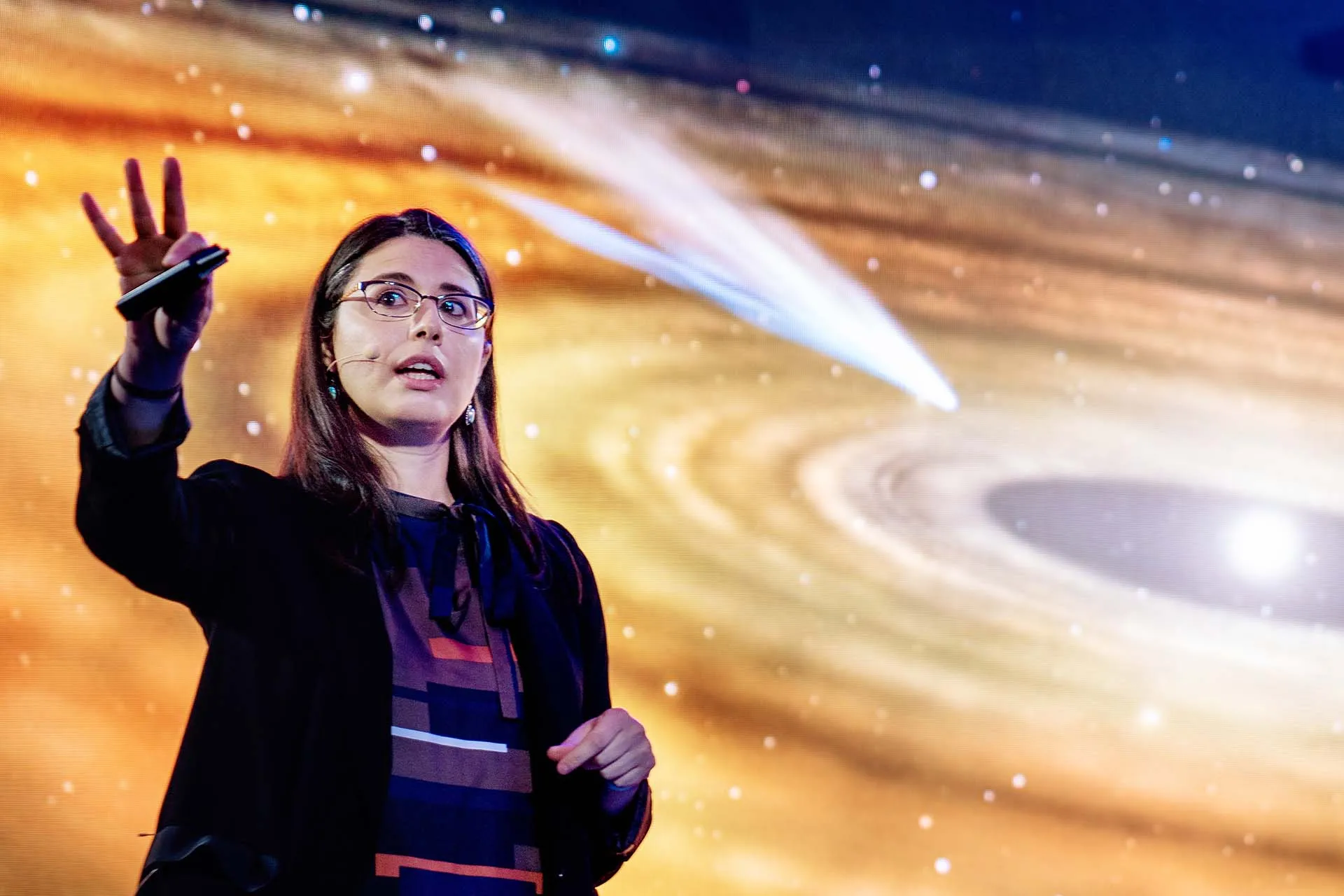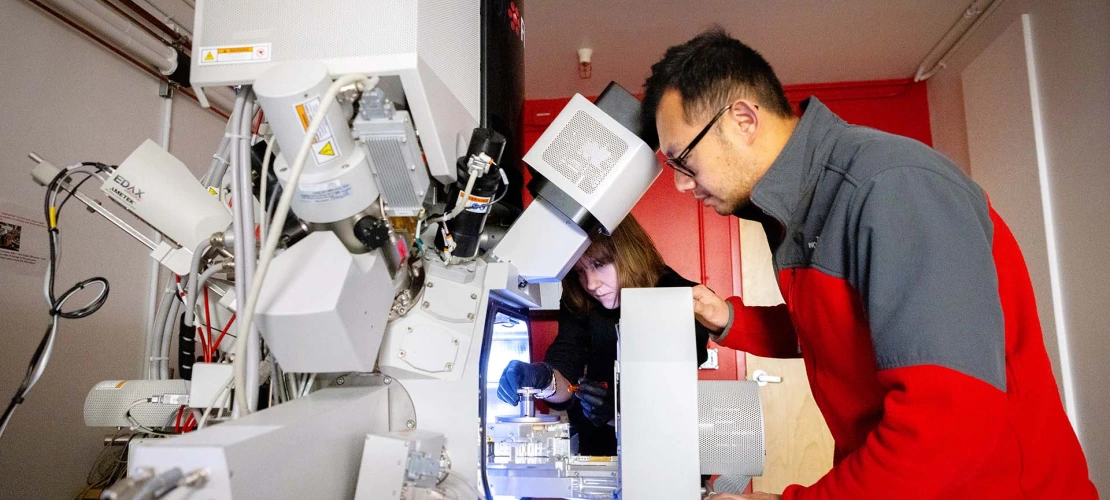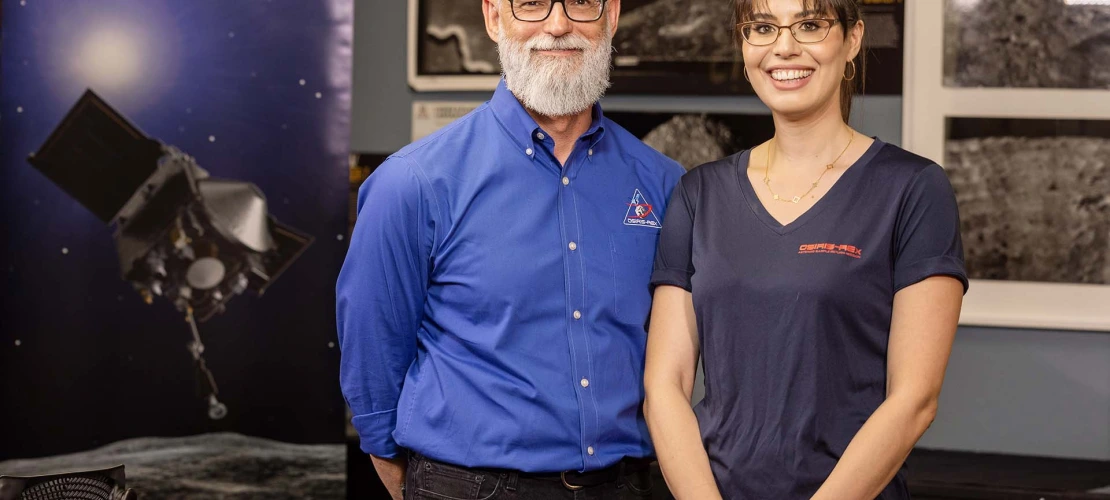Skyward
Dani DellaGiustina, a rising star in planetary science, will soon lead a NASA extended mission, OSIRIS-APEX. To do so, she’ll take over for a longtime mentor, Regents Professor Dante Lauretta.

Dani DellaGiustina, deputy principal investigator of NASA’s OSIRIS-REx mission, speaks at the SXSW Festival in 2022.
Kyle Mittan
In the beginning, Dani DellaGiustina ’08 ’21 hoped to study philosophy and foreign languages. She’d grown up in the desert Southwest, moving around for her father’s military career, with early years in Hereford and Sierra Vista, Arizona, preceding a middle-school move to El Paso. In the borderlands, she marveled at the clear night sky. But she didn’t yet know about astronomy or planetary science, the discipline she’d later rock.
At 16, DellaGiustina enrolled in an introductory astronomy course at El Paso Community College. Philosophy, she found, resided in the cosmos. And many of the “big questions” could be pursued through the space sciences — questions about humanity’s past and future, questions we pose in a thousand ways: tarot cards, tea leaves, archaeological digs.
She soon transferred to the University of Arizona to study astronomy. Here, she met Dante Lauretta ’93, who would become a mentor, colleague, friendly rival and just plain friend.
Today, the two planetary scientists and professors lead a NASA mission, OSIRIS-REx. The spacecraft of the same name is shuttling through space with a half-pound sample of a carbon-rich asteroid, Bennu, in tow. On Sept. 24, the craft will pass over the Utah desert and drop it, via parachute, to Earth — a first for the United States.
Before all that, a great deal had to happen — for the scientists as well as for their mission.
...
They met in 2004. DellaGiustina, then a first-year physics major still drawn to outer space, signed up for a 1-credit colloquium about meteorites through the Lunar and Planetary Laboratory. Lauretta, recruited to teach at his alma mater by the late Michael Drake — then the director of the LPL, a post he would hold until his death in 2011 — told the students about research opportunities in his cosmochemistry lab.
“Email me,” Lauretta said. DellaGiustina did.
In the lab, she started small: polishing meteorite samples, dumping used chemicals. “It was a job,” she says. But spring also brought an independent study, with Lauretta, on meteorites and the birth of the solar system. And a project that imagined asteroids as radiation shields for astronauts flying to Mars earned her a NASA Advanced Concepts fellowship for $10,000. Lauretta served as adviser.
During her college years, DellaGiustina also wrote a peer-reviewed paper and became involved with OSIRIS — the university-led proposed mission that came before OSIRIS-REx, which was steered by Drake but ultimately did not receive a go-ahead from NASA.
A lover of wild landscapes, DellaGiustina graduated in 2008 and moved to Fairbanks, Alaska, to study glaciology. Lauretta wasn’t sure he’d hear from his precocious mentee again. Students come and go every year; most of the time, they don’t return.
'Email me,’ Lauretta said. DellaGiustina did.
...
Lauretta’s first mentor, Ray Jordan, trained show horses in New River, Arizona — a not-quite-town, he says, off Carefree Highway between Phoenix and Flagstaff . Lauretta grew up there, sometimes biking into larger Cave Creek with a buddy to snag a candy bar and soda at the closest Circle K. The junket, he says, took up whole Saturdays.
He began as a ranch hand at the age of 11, cleaning the stables. Later, he witnessed the birth of a colt, named Raja. Jordan entrusted him with the horse’s care. He trimmed his hooves, lunged him in circles. Through age 15, Lauretta worked for Jordan. “He really helped me out a lot,” he says. “And he gave me a lot of positions of responsibility.”
A “cosmic wanderer,” Lauretta came to the university on an undergraduate scholarship in 1988, and his dreams in science found definition. He worked with Carl DeVito, a professor in the math department, on a project about talking to aliens. He got a student job with NASA. He stared at the stars, took long hikes and drove around in a camper van, sometimes sleeping in it.
When he encountered the LPL, he knew what he wanted to do. Back then, the lab was sending rovers to Mars and Saturn.
...
In 2012, DellaGiustina returned to UArizona. She worked for a year and change as a research scientist in the physics department. She had kept in touch with Lauretta, and over lunch one day she told him she was looking for something new. He hired her to join the OSIRIS-REx team as an image-processing scientist.
Today, the two have worked on the mission together for almost a decade. Lauretta is the principal investigator. A Regents Professor, he has overseen OSIRIS-REx since its 2011 inception. DellaGiustina is the mission’s deputy PI, his second-in-command. After earning her doctorate from the university in 2021, she also is an assistant professor in the LPL.
She never stopped working on OSIRIS-REx while earning her degree — in a discipline, geophysics and seismology, entirely unrelated to the mission. DellaGiustina possesses, Lauretta says, “an amazing capacity for intellectual eff ort.” Last year, she was named to Popular Science magazine’s “Brilliant 10” in recognition of her significant early achievement in STEM.
ʻWhen you reach a position of privilege like I have here, you’ve got to really lift up those who are coming after you.’
On the job, DellaGiustina says, she and Lauretta have navigated both high-stress and day-to-day situations. They trust one another; she jokes that he is “the devil you know.” They’ve had it out; they’ve laughed. Lauretta says that DellaGiustina is “just a really fun person to hang out with.”
...
OSIRIS-REx has challenged the duo and their staff of 109 full-time employees and 100-plus students. The asteroid, Bennu, was not as sandy as expected. Instead, it is somewhat rocky, with boulders the size and proximity of buildings on a city block — a truth the mission team did not recognize until its spacecraft had ventured well beyond Earth. OSIRIS-REx is about as big as a RAV-4. The scientists sought to touch it down in a circle the size of a couple of parking spaces. But the sample collection, while messy — the spacecraft kicked up dust when landing — was successful.
Next, after the long-awaited drop-off in an Air Force test range of the Utah desert, will come a quieter period of study. This, of course, is the point of the mission. DellaGiustina and Lauretta say that asteroids tell us about a generalized ancestry: how our planet came to harbor life.
Carbon-bearing asteroids like Bennu, dark as coal, “likely contributed the dominant amount of water to the early Earth,” DellaGiustina says.
After releasing its precious payload, OSIRIS-REx won’t land on Earth; instead, it will venture back into the cosmos, where it has flown since 2016. And DellaGiustina won’t rest, either: Once the Bennu sample reaches Earth, a NASA extended mission, OSIRIS-APEX, will begin.
DellaGiustina will be the principal investigator. She’s taking over from Lauretta, who will be a science co-investigator on APEX — a grandfatherly type, he says, around to offer institutional knowledge and “for all the fun stuff,” but not when he’s not needed.
On OSIRIS-APEX, early career development opportunities will abound. That’s how NASA extended missions work, and DellaGiustina couldn’t be happier. Half of the team for APEX qualifies as “early career,” and this is not accidental. NASA missions don’t happen often; chances to move up can be hard to come by. DellaGiustina’s goal is for the early career scientists on APEX to partner with leads from OSIRIS-REx, eventually assuming their roles.
As for the science, the APEX team will observe a new asteroid, Apophis. This time, the OSIRIS spacecraft will trail its mark through space without ever touching down.
Apophis, a stony asteroid, is brighter in color and smaller than Bennu. Still, like Bennu, Apophis may tell us about life’s origins on Earth. There are signatures in Earth’s water, DellaGiustina notes, not explained by objects like Bennu. Perhaps stony asteroids hold a key.
“A stony asteroid is composed of a lot of silicate materials, which have oxygen atoms,” DellaGiustina says. In orbit, she continues, they are pelted by the solar wind, which contains hydrogen — allowing for water to form, if only a little.
...
Lauretta, who has previously designed board games as a creative outlet, is now writing. He’s almost done with a memoir. And in July, his book with Brian May — the lead guitarist of the rock band Queen, who holds a doctorate in astrophysics — came out through May’s London Stereoscopic Company in joint production with the University of Arizona Press.
“Bennu 3-D” tells the story of the OSIRIS-REx mission. To get the most from its many photographs, the book comes with a stereoscope, which makes a 2D image appear 3D, an area of specialty for May. “It’s 212 pages of asteroid — nonstop asteroid,” Lauretta says.
Lauretta hasn’t forgotten the day he received a phone call from Drake, his own mentor, asking him to join the mission that started as OSIRIS, later evolving into OSIRIS-REx. He’d never taken a call like that, but the conversation heralded a beginning.
“He was the one who really taught me how to be a leader, how to be a role model, and the importance of thinking about the next generation,” Lauretta says. “And he knew Dani. He was really fond of her.“
When you reach a position of privilege like I have here, you’ve got to really lift up those who are coming after you.”
DellaGiustina, Lauretta says, has embraced that responsibility, just as she’s done with every other.
“Getting to watch your students grow and then really step into the role of your equal is just so satisfying,” says DellaGiustina. She mentions Namrah Habib ’18, a mentee of her own who, today, is a doctoral candidate at Oxford University.
“There’s kind of nothing like it,” she says. “And it’s great to see the capacity for them to move beyond you."




